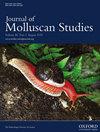15 种瓣鳃目(软体动物门:腹足纲:瓣鳃目)精子形态比较以及与当前系统学和系统发育的相关性
IF 1.2
4区 生物学
Q2 MARINE & FRESHWATER BIOLOGY
引用次数: 0
摘要
通过透射电子显微镜描述了 14 种(4 属)Lottiidae 和 1 种 Acmaeidae 的精子。所有物种都有外生精子,这是一种相对较小、形态简单、自由游动的精子,由具有外部受精能力的物种产生。根据细胞核和顶体的大小、形状和结构,以及中段的特征,在本研究和之前的一些研究中描述的 Lottioidea 物种中可以识别出几种形态学上的精子 "类型"。精子形态在很大程度上支持当前的分类以及系统和系统发育关系。然而,Lottia dorsuosa精子的形态表明其属种地位应重新审查。Niveotectura pallida(前身为 Acmaea pallida)的精子形态与 Tectura 的物种更为相似,而与 Acmaea mitra 的精子形态更为相似,这支持目前将 N. pallida 归入 Lottiidae 的观点。这一结果与最近基于分子数据的系统发育所显示的 N. pallida 与 A. mitra 之间的密切关系不符。本文章由计算机程序翻译,如有差异,请以英文原文为准。
Comparative sperm morphology of 15 species of limpet (Mollusca: Patellogastropoda: Lottioidea) and correlation with current systematics and phylogenies
The spermatozoa of 14 species (four genera) of Lottiidae and one species of Acmaeidae are described by transmission electron microscopy. All have ect-aquasperm, which are relatively small, morphologically simple, free-swimming sperm produced by species with external fertilization. Based on the size, shape and structure of the nucleus and acrosome, as well as features of the mid-piece, several morphological sperm ‘types’ are recognized within the species of Lottioidea described by the present and several previous studies. Sperm morphology largely supports current taxonomy as well as systematic and phylogenetic relationships. However, the morphology of the sperm of Lottia dorsuosa suggests that its generic status should be re-examined. The sperm morphology of Niveotectura pallida (formerly Acmaea pallida) is more similar to that of species of Tectura than of Acmaea mitra, supporting the current placement of N. pallida in the Lottiidae. This result is at odds with the close relationship between N. pallida and A. mitra indicated by recent phylogenies based on molecular data.
求助全文
通过发布文献求助,成功后即可免费获取论文全文。
去求助
来源期刊

Journal of Molluscan Studies
生物-动物学
CiteScore
3.00
自引率
8.30%
发文量
36
审稿时长
3 months
期刊介绍:
The Journal of Molluscan Studies accepts papers on all aspects of the study of molluscs. These include systematics, molecular genetics, palaeontology, ecology, evolution, and physiology. Where the topic is in a specialized field (e.g. parasitology, neurobiology, biochemistry, molecular biology), submissions will still be accepted as long as the mollusc is the principal focus of the study, and not incidental or simply a convenient experimental animal. Papers with a focus on fisheries biology, aquaculture, and control of molluscan pests will be accepted only if they include significant advances in molluscan biology. While systematic papers are encouraged, descriptions of single new taxa will only be considered if they include some ‘added value’, for example in the form of new information on anatomy or distribution, or if they are presented in the context of a systematic revision or phylogenetic analysis of the group.
 求助内容:
求助内容: 应助结果提醒方式:
应助结果提醒方式:


